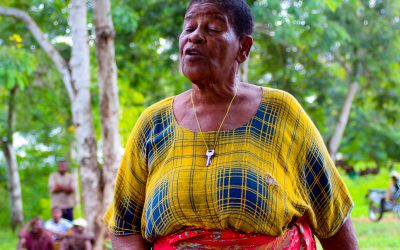The adoption of the Kenyan constitution 2010 and other progressive laws such as the Land Act 2012, Community Land Act 2016, Land Registration Act 2012, Matrimonial Property Act 2013 among other legislation highlighting women rights on land and property gave hope that women would be able to enjoy equal rights as men in relation to land access, ownership and inheritance. Years down the line, not much has changed among Kenyan communities, especially in the rural parts of Kenya. Recent statistics indicate that women own less than 2% of all land titles in Kenya, and only 5% of all the titles issued are owned jointly by men and women. For this reason, women’s opinions in decision making on matters related to land, exploration of natural resources and natural resources management are continually overlooked.
For any community, women inhabiting rural areas remain the major actors on land as their daily activities revolve around utilization of resources found on land such as fetching water, farming for food production, fetching firewood, grazing animals among others. An estimate by the World Bank shows that more than three quarters of Kenya’s farms are run by women. While it is women who carry out these activities, they rarely have a say on what land should be put to what use, since its management and control according to many traditional laws, beliefs and customs is bestowed on men, especially where land is communally owned. It is this struggle that prompted a group of women in 2016 to sign and present the Rural Women Land Rights Charter of Demands to the then Cabinet Secretary for Lands Jacob Kaimenyi, calling for reforms to grant them equal rights to land. In his response according to a report by the Star Newspaper, the Cabinet Secretary said the Ministry would implement chapter 60 of the constitution on land governance to address women’s grievances on land ownership. He called upon women to use the existing laws in incidents where customs are used by certain communities to deny them equal rights.
While the negative use of land through inappropriate exploitation of natural resources, infrastructure projects and other development projects would mainly affect the economic and social livelihood of women, their input on what should be done right is rarely taken in by decision makers. A report by the Natural Resources Alliance of Kenya shows that women barely attended community awareness meetings along the Lapsset corridor in Garissa, Lamu, Tana River and Isiolo counties. In some villages, the meetings would have no female representation, in others, women would attend in few numbers and for others, women would attend in large numbers, but men would dominate the discussions. Their concerns would then go unheard.
Among the sustainable development goals adopted by Kenya in 2015, the goal to achieve gender equity and empower all women and girls aims at giving women equal rights to economic resources, ownership and control over land and other forms of property, financial services, inheritance and natural resources in accordance with the national laws. While this looks easy in writing, it remains a hard goal to achieve as land ownership in Kenya is mainly vested in fathers who customarily pass it to their sons or other male relatives, making it hard for women to secure rights, except through their husbands. This puts women at the risk of not sharing in the benefits that would be gained from natural resources explorations, and compensations for land in case of displacement. To achieve the anticipated fairness and equality, there is therefore a great need to balance traditions and modern day legislation.
In order to align the current legislation and institutional reforms with community traditions, customs and practices, there is need for awareness creation on women land rights and natural resources rights. Media campaigns and dialogues at the grassroots involving council of elders and other community leaders would go a long way in deconstructing the existing negative attitudes, beliefs and perceptions and enlightening communities on the importance of women’s opinion in land and natural resources decision making, and the need to have them involved beyond community meetings level.
As highlighted in the World Bank’s Gender Mainstreaming Strategy in 2001, societies that discriminate by gender tend to experience less rapid economic growth and poverty reduction than societies that treat males and females more equally, and that social gender disparities promote economically inefficient outcomes. Through continuous capacity building, community exchange visits, information sharing and sensitization, communities may soon realize that it is possible to have women share in the responsibilities of land and natural resources management and benefit sharing while still upholding the importance of the formal and informal institutions that have long controlled these processes.
Thanks a million and please keep up the rewarding work. viagra pills I seriously appreciate individuals like you.

